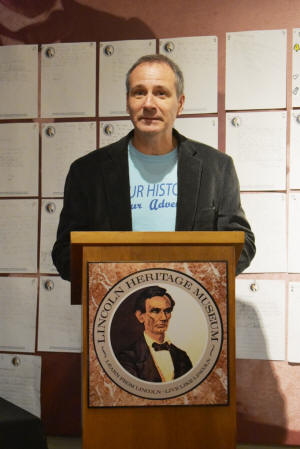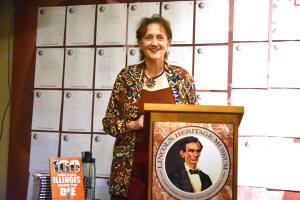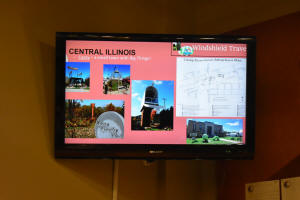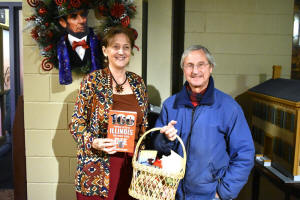|
 This
series of books originally chronicled cities, but has since added
U.S. states. As a nonfiction writer, when Holmes discovered that the
series had not yet covered the state of Illinois, she contracted
with the publisher to research and write this title. As a native
Illinoisan, Holmes felt qualified to explore and represent the whole
of the state because of her travels within the state and from living
in different areas. Originally from Manteno, Holmes started
traveling with her mother at age seven. She says that she had a
rural upbringing and as an adult moved closer to Chicago for
employment. She credits these things with giving her a balanced
approach to the book. Her overall approach to writing the book was
“to tell the Illinois story through a collection of experiences.” This
series of books originally chronicled cities, but has since added
U.S. states. As a nonfiction writer, when Holmes discovered that the
series had not yet covered the state of Illinois, she contracted
with the publisher to research and write this title. As a native
Illinoisan, Holmes felt qualified to explore and represent the whole
of the state because of her travels within the state and from living
in different areas. Originally from Manteno, Holmes started
traveling with her mother at age seven. She says that she had a
rural upbringing and as an adult moved closer to Chicago for
employment. She credits these things with giving her a balanced
approach to the book. Her overall approach to writing the book was
“to tell the Illinois story through a collection of experiences.”

Museum Director Ron Keller welcomed the audience
gathered at the Lincoln Heritage Museum to hear Holmes' book talk
and introduced her. This is Holmes fifth nonfiction book, and the
presentation at the Lincoln Heritage Museum was her 54th book event
in 16 months. Holmes says about “100 Things To Do in Illinois” that
she “scoured Illinois for consistent guest experiences in the arts,
entertainment, food, parks, culture, history, sports, and geology.”
The city of Lincoln rated coverage in the book for the Lincoln
Heritage Museum, Courthouse Square, the Depot, and the World’s
Largest Covered Wagon. She said that Lincoln’s location on old Route
66 was also a clincher for inclusion in the book.

After introductions, Holmes began her presentation
with a nod to the “bucket list” series’ title with the question,
“Why a bucket list?” She said creating a bucket list is about
setting priorities. To fulfill a bucket list: 1) Write it down and
2) Go while you feel like it because someday you won’t feel like it,
which is advice from Holmes’ mother who lived to age 90. The
publisher asked Holmes to give tips and make lists, for example, “if
you like Frank Lloyd Wright’s architecture, then you may like the
Dana-Thomas House in Springfield.” Therefore, the “100 things to do”
described in the book is closer to 200 things to do.

Holmes included plenty of Abraham Lincoln sites
because Illinois is the Land of Lincoln, but she also asked, “What
else is there in Illinois?” Holmes then described and presented
photos of interesting and lesser known experiences available in
Illinois. She began with photos of glamping in a restored caboose
next to a herd of bison. This opportunity, along with regular cabin
stays, is available at Wildlife Prairie Park. She asked if anyone
had ever touched the Berlin Wall. This experience is available for
free in Eureka at the Reagan Peace Garden. Illinois also offers the
chance to attend an authentic Pow-Wow at the American Indian Center
every fall.
Holmes recommends a visit to the Garden of the Gods for natural
beauty where sleeping in a tree house resort is another little-known
opportunity. Anyone interested in driving a steam engine train can
fulfill her dream in Monticello. Anyone wanting an introduction to
whitewater rafting can visit man-made rapids in Yorkville.
Holmes told the audience about some Illinois
surprises. Illinois has had two state fairs since 1986, the Illinois
State Fair and the DuQuoin State Fair. Illinois has an expansive
National Forest from river to river in the southern part of the
state. Olney has a population of white squirrels, and Wildlife
Prairie Park has white bison.
[to top of second column] |

Another surprising feature of Illinois is the many
wineries. Wine aficionados can follow the Shawnee Hills Trails in
the south as well as the Mississippi Valley Trail and the Wabash
Trail.
Another of Holmes' goals for the book was to show
what Illinois was alongside what Illinois is. Illinois has ancient
burial mounds at Indian Mounds Park and at Cahokia, and Chicago
boasts the DuSable Black History Museum. Illinois has a particular
history as a free state surrounded by slave states prior to the
Civil War. Illinois’ abolitionist and Underground Railroad
associations should be better known, she believes, particularly the
story of the Lovejoy brothers.

Originally from Maine and living in St. Louis, Elijah
Parish Lovejoy was an abolitionist, Christian minister, and editor
of the anti-slavery newspaper the Observer. According to the Library
of Congress, “Lovejoy’s editorials raised local ire while they
increased national circulation. A group of local citizens, including
the future Senator Thomas Hart Benton, declared that freedom of
speech did not include the right to speak against slavery. As mob
violence increased over the issue, Lovejoy, now a husband and
father, decided to move his family to Alton, across the Mississippi
River in the free state of Illinois… Mobs had destroyed Lovejoy’s
presses on a number of occasions, but when a new press arrived in
November 1837, the violence escalated. No sooner was the new press
offloaded from the steamboat Missouri Fulton than a drunken mob
formed and tried to set fire to the warehouse where it was stored.
When Lovejoy ran out to push away a would-be-arsonist, he was shot.”
Officials in Illinois made little comment about the murder with one
exception: Twenty-eight year old State Representative Abraham
Lincoln. Lincoln made note of the first martyr to free press in the
United States. After Lovejoy’s death, his brother Owen Lovejoy,
stated “I will harbor any freedom-seeker” and became a “conductor”
on the Underground Railroad. He later became a Congressional
Representative for the 35th district of Illinois and a staunch
supporter of Abraham Lincoln.
Other recommended sites include Illinois’ oldest and largest Amish
area around Arthur and the Mormon temple and original homes and
buildings at Nauvoo. A historic shopping district and sock monkey
museum are points of interest in Long Grove. A historic square and
opera house where Orson Welles got his start draw visitors to
Woodstock, also the site where the movie Groundhog Day was filmed.
Jane Addams’ Hull House in Chicago is worthy of a visit, but also
her birthplace and burial in Cedarville.

At the conclusion of the presentation, Holmes left
time for a Q and A. In answer to a question about the strangest
thing she has encountered, she mentioned the World’s Largest
Teeter-Totter (it works!) located in Casey along with many other
World’s Largest items. For military interest, she recommends the
Arsenal Island installation. She said her biggest message is “to get
out in your backyard and your region and support the local
businesses that you find.”

After the Q and A, Holmes signed copies of her book
for attendees. She held a drawing for a basket of Illinois products
for everyone who purchased her book, won by Curtis Fox. For more
information and to order her books, please visit https://www.melanieholmesauthor.com.
[Stephanie Hall] |